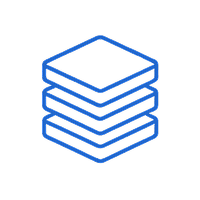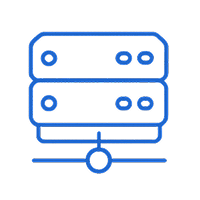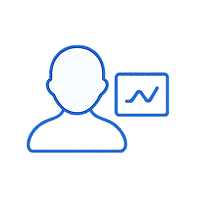Sumo Logic’s core strength lies in its robust cloud-native SIEM and security analytics, providing teams with powerful log correlation and threat detection capabilities. However, as data volume grows, its observability costs and performance can become increasingly difficult to manage. With the APM market projected to reach USD 46.89 billion by 2030, teams are demanding more comprehensive, affordable, and vendor-neutral alternatives.
CubeAPM is the best alternative to Sumo Logic. CubeAPM delivers complete observability with real-time MELT coverage, smart sampling, and native OpenTelemetry support. With no per-user fees and ingestion-based pricing of $0.15/GB, CubeAPM offers up to 80% cost savings over Sumo Logic.
In this article, we’ll break down the top 7 alternatives to Sumo Logic in 2025—evaluating tools based on their feature depth, deployment options, pricing transparency, and OpenTelemetry readiness.
Top 7 Sumo Logic Alternatives
- CubeAPM
- Datadog
- Coralogix
- New Relic
- Dynatrace
- Splunk AppDynamics
- Better Stack
APM Tools Comparison: Sumo Logic vs CubeAPM vs Others (2025)
| Tool | *Pricing(Small, Mid, Large) | OTEL Native | Support TAT | Deployment Option |
| CubeAPM | Small: $2,080 Mid: $7,200 Large: $15,200 | Yes | Within minutes | Self-hosted |
| Sumo Logic | Small: $4,641 Mid: $16,065 Large: $33,915 | *No | 1hr to 1day | SaaS only |
| New Relic | Small: $7,896 Mid: $25,990 Large: $57,970 | *No | 2hrs to days | SaaS only |
| Coralogix | Small: $4,090 Mid: $13,200 Large: $29,000 | Yes | Within minutes | SaaS only |
| Datadog | Small: $8,185 Mid: $27,475 Large: $59,050 | *No | <2hrs-48hrs | SaaS only |
| Dynatrace | Small: $7,740 Mid: $21,850 Large: $46,000 | *No | 4hrs to days | SaaS and Self-hosted |
| Splunk Appdynamics | Small: $2,650 Mid: $9,825 Large: $20,150 | *No | 2hrs to days | SaaS and Self-hosted |
| Better Stack | Small: $5,723 Mid: $20,550 Large: $43,350 | *No | Within hours | SaaS only |
*All pricing comparisons are calculated using standardized Small/Medium/Large team profiles defined in our internal benchmarking sheet, based on fixed log, metrics, trace, and retention assumptions. Actual pricing may vary by usage, region, and plan structure. Please confirm current pricing with each vendor.
*OTEL Sources: Datadog uses proprietary SDKs; Splunk AppDynamics uses collectors; Sumo Logic uses collectors, Better Stack uses collectors.
Why Look for Sumo Logic Alternatives?
While Sumo Logic offers strong capabilities for log analytics and cloud security, many engineering and DevOps teams are re-evaluating its fit for full-stack observability. The shift toward unified MELT (Metrics, Events, Logs, Traces) platforms, OpenTelemetry-native pipelines, and cost-effective scalability has exposed key limitations:
1. Expensive at Scale, Especially under Heavy Data Volume
Several users report that as log ingestion and data retention grow, costs escalate quickly. For teams handling large log volumes or long-term retention, budgeting becomes difficult, and value per dollar decreases.
“Some of the things that I don’t like about Sumo Logic is that its cost is higher than similar tools.” (G2)
2. Complexity in advanced queries and steep learning curve
While basic log search works, advanced analytics, custom queries, and sophisticated alerting require substantial familiarity. Some users find the query syntax and dashboard configuration non-intuitive or hard to master.
3. Slow Performance
Users report that Sumo Logic can become noticeably slow when handling large datasets or complex queries. Searches may take longer to return results, dashboards can lag while loading, and the UI may feel unresponsive during peak ingestion periods. In some cases, these slowdowns also affect alerting delays, making it harder for teams to rely on Sumo Logic for real-time incident detection and rapid troubleshooting.
4. Overwhelming User Interface
Users frequently mention that the updated Sumo Logic interface feels less intuitive than the previous version. ey features and shortcuts available in the old UI are missing or harder to access, forcing extra clicks and slowing down workflows. Navigation between dashboards, queries, and alerts can feel disjointed, and some layouts are less customizable than before. As a result, teams experience reduced efficiency during troubleshooting and daily monitoring tasks.
Criteria for Suggesting Sumo Logic Alternatives
When evaluating alternatives to Sumo Logic, we considered what modern engineering, SRE, and platform teams need most from an observability platform in 2025:
1. Full MELT Stack Coverage
The platform should offer first-class support for Metrics, Events, Logs, and Traces—all in one place. Teams want to correlate logs with traces, metrics with user experience, and get instant RCA, not switch tabs across tools.
2. Active OpenTelemetry and Prometheus Support
Vendor-neutral observability is non-negotiable. Active OTEL support ensures scalable, flexible instrumentation across any service, language, or cloud. Prometheus compatibility is essential for Kubernetes-native environments.
3. Smart Sampling Features
Efficient sampling strategies like smart or tail-based sampling ensure that only high-value traces are ingested. This reduces ingestion costs and improves visibility without data overload—unlike tools with static 1% or 5% sampling rates.
4. Transparent, Predictable Pricing
Teams prefer usage-based pricing—like per GB ingested or per host—over unpredictable daily ingest caps or overage penalties. ost transparency becomes especially critical at scale.
5. Fast Setup and Integrations
Top alternatives should support agentless onboarding and compatibility with popular agents—like those from Datadog, New Relic, or Elastic—to make switching seamless.
Sumo Logic Overview

Known For
Sumo Logic is known as a cloud-native analytics and security intelligence platform built for real-time machine data ingestion, advanced search, and SIEM use cases. It’s widely used by DevOps, security, and cloud infrastructure teams who need scalable log monitoring and alerting, particularly in AWS and Kubernetes environments.
Key Features
- Log Management & Ingestion: Real-time indexing and search for structured and unstructured logs across services, containers, and cloud infrastructure.
- Cloud SIEM & Compliance: Built-in threat intelligence, alert correlation, and audit trail reporting for SOC2, HIPAA, PCI, and more.
- Basic APM & Tracing: Supports OpenTelemetry and Prometheus-based tracing and metrics, though these features are less mature compared to log analytics.
- Real-Time Dashboards: Visual dashboards for query results, anomaly detection, and infrastructure health summaries.
Standout Features
- Proprietary query language (LogReduce, LogCompare) for large-scale log analysis
- Built-in cloud SIEM and threat detection dashboards
- Large integration ecosystem across cloud-native stacks, CI/CD tools, and containers
Pros
- Robust log ingestion and correlation at cloud scale
- Useful for both DevOps (log observability) and SecOps (SIEM) use cases
- Wide range of native integrations and cloud-friendly design
- Built-in security analytics and regulatory compliance templates
- Highly scalable for high-ingest environments
Cons
- Users find the UI cumbersome, hindering usability
- Steep learning curve, especially for Sumo Logic’s complex queries
- Slow performance due to UI unresponsiveness
- Expensive, especially when scaling
Best For
Cloud-native teams focused on log analytics, security compliance, and threat detection in large AWS/GCP environments. Particularly suited for SecOps and DevOps workflows that don’t require full-stack observability.
Pricing & Customer Reviews
- Starts around $3.14 per TB scanned
- G2 Rating: 4.3/5
Top 7 Sumo Logic Alternatives
1. CubeAPM

Known For
Looking for a robust APM that captures telemetry from both applications and infrastructure, delivers actionable insights through metrics and logs, and offers blazing-fast performance with enterprise-grade data control? ook no further—CubeAPM is your go-to Application Performance Monitoring (APM) platform.
Infrastructure and AWS Support. ubeAPM offers out-of-the-box monitoring for popular systems, including Kubernetes, Redis, Kafka, MySQL, and MS SQL. It also provides automated support for all major AWS services like EC2, RDS, EBS, DynamoDB, and Lambda—offering complete infrastructure visibility in a single platform.
Key Features
- Real-Time MELT Observability: Offers complete MELT stack monitoring—metrics, events, logs, traces—with native support for RUM, synthetics, and error tracking.
- Smart Sampling Engine: Context-aware sampling dynamically retains high-value traces (e.g., errors, spikes, latency anomalies), ensuring you pay for signals—not noise.
- Native OpenTelemetry Support: Full OTEL compliance allows plug-and-play instrumentation across services, with no lock-in or vendor-specific agents.
- Unified Agent Compatibility: Works seamlessly with existing agents from Datadog, Prometheus, and New Relic—no heavy migrations required.
Standout Features
- Automated Smart Sampling: Eliminates the need to predefine rates—uses runtime signals to decide what to retain.
- Blazing-Fast Support: Slack and WhatsApp support with minute-level response times from core engineering.
- Zero Egress Architecture: Data stays in your cloud, eliminating egress costs and ensuring compliance.
- All-in-One Stack: Logs, traces, metrics, synthetics, and RUM are natively integrated—no fragmented views.
Pros
- Transparent, usage-based pricing ($0.15/GB ingestion)
- Smart sampling improves signal-to-noise and reduces cost
- Supports MELT out of the box with no paid add-ons
- Native OTEL support
- Fast setup and compatibility with existing agents
Cons
- Not suited for teams looking for off-prem solutions
- Strictly an observability platform and does not support cloud security management
Best For
- Engineering orgs seeking lower cost and control over telemetry
- Startups and mid-sized teams scaling fast, but watching budgets
Pricing & Customer Reviews
- Ingestion-based pricing of $0.15/GB
- Rating: 4.7 / 5 (based on pilot programs, Slack feedback, and demos)
CubeAPM vs Sumo Logic
While Sumo Logic is built around native infrastructure, full MELT, and security analytics, CubeAPM delivers unified observability across MELT, with smart sampling, native OTEL, and predictable pricing. Sumo Logic’s cloud-only model lacks self-hosting. ubeAPM also provides faster support and easier setup—making it ideal for modern, microservices-based teams.
2. Datadog

Known For
A comprehensive SaaS-based monitoring and security platform that offers observability across infrastructure, APM, logs, RUM, and more. Datadog is popular in enterprises with complex, cloud-native environments due to its breadth of integrations and rich dashboards.
Key Features
- Full MELT Stack Coverage: Datadog supports metrics, events, logs, and traces, along with RUM, synthetics, error tracking, and CI/CD observability.
- 900+ Native Integrations: Built-in support for a vast ecosystem: AWS, Azure, Kubernetes, Docker, Jenkins, PostgreSQL, etc.
- Rich Dashboards and Visualizations: Customizable UI with graphs, service maps, flame charts, and log overlays.
- AI-Powered Alerting (Watchdog): Automatic anomaly detection and forecasting using built-in ML models.
Standout Features
- Extensive Feature Catalog: From APM and logs to cloud cost monitoring and security events—Datadog is deeply modular.
- Unified Agent: Single agent for collecting logs, metrics, traces, and events.
- Powerful UX: Real-time drill-downs, service dependencies, and custom widgets for multi-team workflows.
Pros
- Full observability suite in one platform
- Intuitive UI and fast dashboarding
- Deep integration ecosystem
- Wide product surface area (e.g., mobile APM, CI, cloud costs)
- Great for cross-functional DevOps/SecOps/Infra teams
Cons
- High Cost at Scale: Charges separately for APM, infra, logs, costs can skyrocket with usage
- Billing Complexity: Pricing tied to host count, event volume, custom metrics, ingestion size, and retention windows
- Steep learning curve and complexity for newcomers
- Interface and configuration overload — can be overwhelming
Best For
Large enterprises seeking all-in-one observability and security across infrastructure, apps, and teams—particularly those prioritizing deep integrations and UI richness over deployment flexibility or cost efficiency.
Pricing & Customer Reviews
- APM (Pro Plan): $31/host/month
- Infra Monitoring(Pro Plan): $15/host/month
- Infra Cost: starting at $15/host/month
- G2 Rating: 4.4/5
Datadog vs Sumo Logic
Datadog offers broader observability coverage than Sumo Logic—including RUM, synthetics, CI visibility, and security events. However, both platforms tend to be extremely expensive at scale. Datadog is more advanced in APM and metrics; Sumo is stronger in SIEM workflows.
3. Coralogix
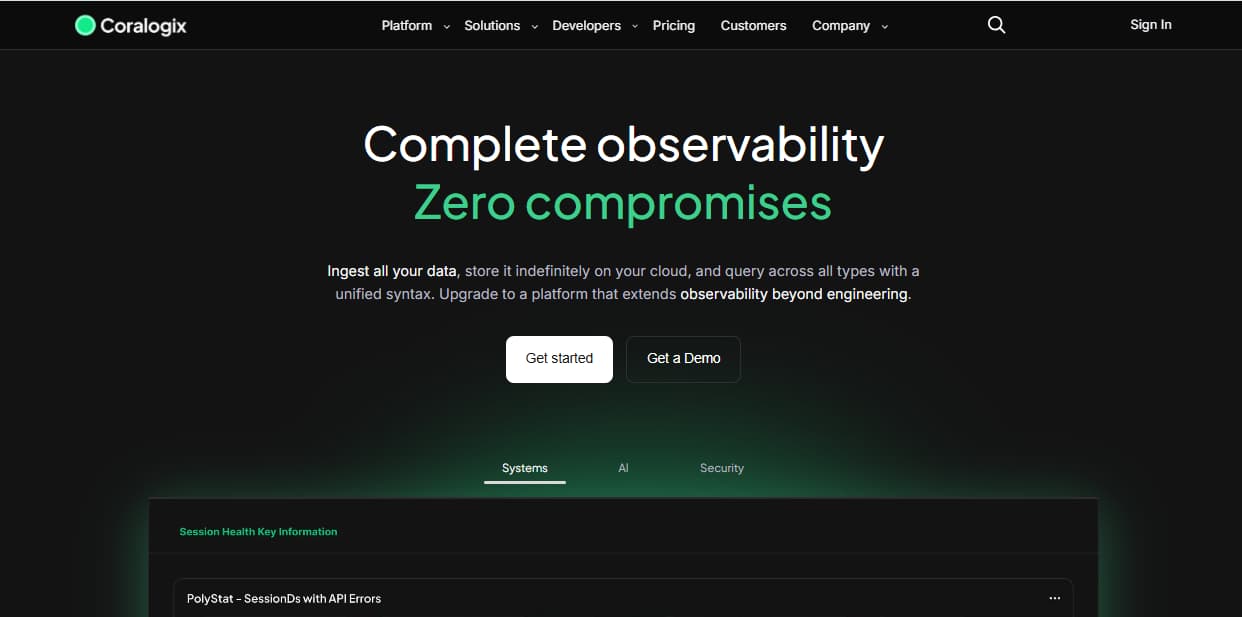
Known For
Coralogix is best known as a full-stack observability platform offering advanced stream processing, customizable log pipelines, and OpenTelemetry-based ingestion. Coralogix is designed for teams prioritizing log analytics, pipeline flexibility, and cost optimization—though with trade-offs on full-stack observability and compliance.
Key Features
- Streama™ Architecture: Processes and routes data during ingestion using rules-based pipelines—enabling cost savings through selective indexing, transformation, or archiving.
- Archive-to-Query (Cold Search): Logs can be routed directly to a customer-owned storage bucket (e.g., Amazon S3) and queried on demand—reducing storage cost.
- Built-in Enrichment and Alerting: Supports data parsing, transformations, and pre-storage alerts with support for metric and event generation.
- OpenTelemetry Ingestion: Coralogix supports native OTEL ingestion for logs, metrics, and traces—though MELT unification remains limited in practice.
Standout Features
- Pipeline Control: Route and transform data based on content, labels, or metadata before indexing or archiving.
- Customer-Controlled Archive: Coralogix does not charge for archived telemetry stored in your cloud—only the cloud storage cost applies.
- 24/7 Chat Support: Includes live chat and email with varying SLAs depending on plan.
Pros
- Deep log pipeline customization
- Cost control through selective routing and indexing
- Native OTEL ingestion support
- Cloud and optional on-prem hybrid options
- Archival flexibility for long-term compliance needs
Cons
- Costs can rise quickly at higher data volumes
- Missing features, such as in alter sections, user API limits userbility
- Steep learning curve
- Users find the UI challenging, especially for beginners
Best For
Log-heavy engineering and SecOps teams that want fine-grained control over log ingestion pipelines and cost efficiency through archive routing—particularly in regulated or cost-sensitive cloud environments.
Pricing & Customer Reviews
- Logs: $0.42/GB
- Traces: $0.16/GB
- Metrics: $0.05/GB
- G2 Rating: 4.6/5
Coralogix vs Sumo Logic
Coralogix provides more ingestion flexibility and archival cost control than Sumo Logic, thanks to Streama pipelines and archive-to-query workflows. However, both routes data through their cloud, accumulating egress cost concerns. CubeAPM presents a more modern alternative with unified observability, smarter ingestion, and true data localization.
4. New Relic

Known For
A usage-based, full-stack observability platform that covers everything from APM and infrastructure monitoring to logs, RUM, synthetics, and mobile telemetry. New Relic is recognized for its unified Telemetry Data Platform (TDP) and dashboarding powered by its query language, NRQL.
Key Features
- Full MELT Observability: Offers integrated support for metrics, events, logs, traces, RUM, synthetics, and error tracking—all accessible from a single UI.
- Telemetry Data Platform (TDP): Acts as a centralized ingestion and query engine for all telemetry data—including OTEL, Prometheus, and custom agents.
- Dashboards & NRQL Analytics: Real-time data querying and flexible dashboards with New Relic Query Language (NRQL) for in-depth telemetry analytics.
- RUM, Synthetics, and Mobile Monitoring: Robust browser and mobile performance monitoring with detailed session tracking and uptime monitoring.
- Integrations & Auto Instrumentation: Supports auto-instrumentation for many languages and platforms; integrates with AWS, Azure, Kubernetes, and more.
Standout Features
- Telemetry Data Lake: Stores and queries logs, metrics, and traces from a unified backend.
- Rich Dashboards with NRQL: Enables deep slice-and-dice analytics across telemetry dimensions.
- All-in-One Observability: Offers MELT support in one suite (though some depth depends on using New Relic agents).
Pros
- End-to-end observability with one UI
- Flexible ingestion of OpenTelemetry and Prometheus data
- Strong support for frontend (RUM) and mobile observability
- Easy onboarding with auto-instrumentation for many languages
- Mature alerting, SLOs, and anomaly detection capabilities
Cons
- Pricing Complexity: Charges for ingestion and per user—can lead to spiraling costs
- User Licenses Are Expensive: Full-access licenses start at $349/user/month
- Users find the initial setup complex, requiring significant knowledge
- Challenges with limited features, including restricted access
Best For
Mid-to-large DevOps teams that want quick setup, rich dashboards, and all-in-one observability—and are comfortable with cloud-only, usage-based pricing.
Pricing & Customer Reviews
- Free: 100GB/month ingested
- Data ingested: $0.40/GB beyond the free 100 GB
- Full Platform User: $418.80/user(for monthly pay as you go)
- G2 Rating: 4.4/5
New Relic vs Sumo Logic
New Relic offers broader full-stack observability with strong APM, rich instrumentation, and deeper MELT coverage, while Sumo Logic stands out with powerful SIEM and security analytics on top of its log, metric, and trace capabilities. New Relic provides stronger application-level insights, whereas Sumo Logic excels in threat detection and security workflows.
5. Dynatrace

Known For
A powerful enterprise observability platform with deep AI-powered root cause analysis, full-stack telemetry, and native Kubernetes support. Dynatrace is especially suited for large enterprises managing complex, containerized environments.
Key Features
- Davis® AI Engine: Dynatrace’s core differentiator—automatically correlates logs, metrics, traces, and dependencies to deliver real-time root cause analysis and impact scoring.
- OneAgent Auto-Instrumentation: Single agent that captures logs, traces, metrics, RUM, and more—eliminates the need for multiple sidecars or exporters.
- Full MELT Stack Support: Supports metrics, logs, events, traces, RUM, and synthetics—offering a comprehensive and unified observability experience.
- SLO Management and Business Analytics: Enables mapping of technical SLIs/SLOs to business KPIs for service-level accountability.
Standout Features
- Davis AI: Eliminates alert storms with automatic RCA and causation graphs—ideal for reducing MTTR in large environments.
- Auto-Kubernetes Discovery: Monitors dynamic infrastructure (e.g., EKS, AKS, GKE) with zero manual tagging.
- Partial On-Prem Support: Hybrid deployment available via Dynatrace Managed.
Pros
- Best-in-class automation with AI-driven diagnostics
- Rich visualizations and service flow analysis
- OneAgent simplifies deployment and reduces manual instrumentation
- Enterprise-grade security, compliance, and audit support
- Strong SRE features (SLOs, impact analysis, event correlation)
Cons
- Expensive: Premium pricing based on host consumption and data units (DDUs)
- Licensing Complexity: Costs spread across metrics, traces, logs, hosts, sessions, and DDUs—difficult to predict
- Steep learning curve and heavy setup requirements
- UI and feature depth can feel overwhelming
Best For
Global enterprises that need real-time AI-powered observability, deep Kubernetes and infrastructure insights, and are willing to trade cost and flexibility for automation and scale.
Pricing & Customer Reviews
- Full-Stack Monitoring: $58 /month/8 GiB host
- Infra Monitoring: $29/month/8 GiB host
- G2 Rating: 4.5/5
Dynatrace vs Sumo Logic
Dynatrace far exceeds Sumo Logic in APM, infrastructure, and root cause automation. Sumo Logic, meanwhile, dominates security analytics, infra monitoring, and full-stack observability. Dynatrace utilizes Davis AI for noise reduction, whereas Sumo relies on ingestion filters. If you’re looking for enterprise power with more pricing control, OTEL-first design, and flexible deployment, CubeAPM offers a simpler, smarter alternative.
6. Splunk AppDynamics
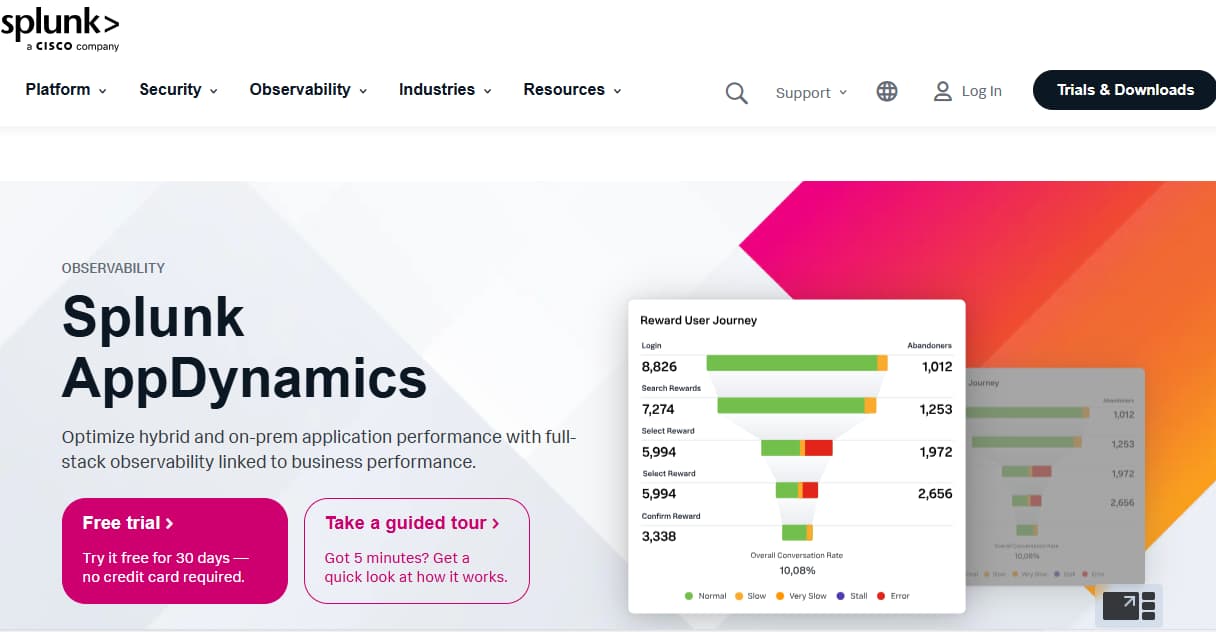
Known For
Enterprise-grade observability tools with strong APM and infrastructure monitoring. Splunk APM (from the SignalFx acquisition) and AppDynamics (a Cisco product) are often used in regulated, traditional enterprises that prioritize high trace fidelity (Splunk) or deep code diagnostics (AppDynamics).
Key Features
- NoSample™ Tracing: Captures and ingests 100% of trace data (without head/tail sampling) and indexes on demand—ensures full fidelity.
- Tag Spotlight + Trace Search: Real-time search across high-cardinality attributes like user IDs, endpoints, containers, and spans
- Streaming Architecture: Built for real-time telemetry with sub-second latency—ideal for high-volume microservices.
- Business Transaction Monitoring: Tracks application workflows end-to-end with code-level diagnostics and response-time breakdowns.
Standout Features
- High-scale, full-fidelity tracing is ideal for real-time environments with extreme cardinality.
- Deep JVM/.NET instrumentation and business-transaction mapping tied to code.
Pros
- Rich code-level APM with powerful dashboards and SLO visualizations
- Both have strong enterprise support and security posture
- Good integrations with cloud, legacy systems, and infra
Cons
- Legacy UI and steep learning curve
- Pricing becomes expensive as environments grow
- Complicated licensing and cost structure
- Setup and advanced configuration require significant effort
Best For
Enterprises tied to traditional infrastructure or monoliths that need deep diagnostics tied to business transactions.
Pricing & Customer Reviews
- AppDynamics APM: starts at $33/month/CPU core
- Infra Monitoring: starts at $6/month/CPU core
- G2 Ratings: 4.3/5
Splunk AppDynamics vs Sumo Logic
Splunk AppDynamics offers deeper APM capabilities, but lacks Sumo Logic’s SIEM capabilities. CubeAPM stands apart with smart sampling, full MELT coverage, OpenTelemetry-native ingestion, and self-hosted or hybrid options—without the cost or complexity.
7. Better Stack

Known For
A lightweight, developer-friendly observability suite focused on uptime monitoring and incident management, with a clean UX and fast alerting. etter Stack (formerly Better Uptime + Logtail) is often adopted by small to mid-sized engineering teams that need a simple, fast, and affordable alternative to legacy logging tools.
Key Features
- Logtail – SQL-Based Log Management: Real-time log aggregation and filtering with an intuitive SQL-like syntax, powered by ClickHouse backend.
- Uptime & Incident Monitoring: Integrated uptime checks, incident escalation policies, and public status pages—designed to replace tools like Pingdom or Statuspage.
- Alerts & Integrations: Alerting via Slack, Teams, PagerDuty, email, and Webhooks with routing rules, maintenance windows, and on-call schedules.
- Dashboards & Collaboration: Built-in dashboards, visual timeline, and shared log views for team debugging.
- Quick Setup & Clean UI: SaaS-based deployment, no infrastructure management, and a modern developer-first design.
Standout Features
- SQL for Logs: Search logs using structured queries like SELECT * FROM logs WHERE level = ‘error’
- Status Page + Monitoring + Logs in One: Combines observability, uptime, and incident management in a lightweight bundle
- Lightning-Fast Setup: Deploy in minutes with minimal config or agent tuning
Pros
- Intuitive, modern UX for small teams
- Fast and simple log search with SQL syntax
- Integrated uptime monitoring and incident response
- Competitive free tier and pay-as-you-grow model
- Ideal for bootstrapped engineering orgs
Cons
- Users find the expensive, particularly for startups
- Users have reported missing features, such as outgoing webhooks
- The limited features are restrictive, especially for advanced needs
- Users find the initial setup complex
Best For
Startups, small teams, and solo developers who need logs, uptime, and simple alerting in one place—without the complexity of full-stack observability platforms.
Pricing & Customer Reviews
- Free tier available for personal projects
- Logs: $0.15/GB
- Metrics: $7.50, 2TB included
- Errors: $0.000075/exception
- G2 Rating: 4.5/5
Better Stack vs Sumo Logic
Better Stack is far simpler and more affordable than Sumo Logic, but lacks Sumo Logic’s massive integration ecosystem and security monitoring capabilities. For teams needing broader coverage and compliance options, CubeAPM is the natural upgrade path.
Conclusion: Choosing the Right Sumo Logic Alternative
As engineering teams scale complex, distributed systems, observability needs are shifting from log-centric platforms with rigid pricing models to OpenTelemetry-native, full-stack solutions that offer cost transparency, deployment flexibility, and complete MELT coverage, while Sumo Logic provides strong log analytics and SIEM capabilities, its limited trace support, SaaS-only architecture, and unpredictable ingest-based pricing create operational and compliance challenges for modern DevOps and SRE teams.
CubeAPM emerges as the most balanced Sumo Logic alternative—offering full MELT observability (metrics, events, logs, traces), smart contextual sampling, OTEL-native compatibility, and flat-rate pricing at $0.15/GB. With real-time Slack-based support, 1-hour onboarding, and deployment options across cloud and on-prem, CubeAPM enables teams to scale observability without the complexity, data egress costs, or vendor lock-in found in platforms like Sumo Logic.
Disclaimer: The information in this article reflects the latest details available at the time of publication and may change as technologies and products evolve.
FAQs
1. Why are companies looking for Sumo Logic alternatives?
Many teams move away from Sumo Logic due to its log-centric architecture, opaque ingest-based pricing, and limited full-stack. Organizations that adopt OpenTelemetry and microservices need deeper tracing, infrastructure metrics, and flexible deployment capabilities that Sumo Logic lacks.
2. What is the best alternative to Sumo Logic?
CubeAPM is a top alternative, offering full MELT coverage (Metrics, Events, Logs, Traces), smart sampling, OpenTelemetry-native support, and predictable flat-rate pricing at $0.15/GB. It supports both cloud and self-hosted deployments, making it ideal for compliance-sensitive and fast-scaling teams.
3. Is Sumo Logic suitable for full observability use cases?
Yes, Sumo Logic is strong in log analytics and SIEM, but it lacks native OTEL support. Alternatives like CubeAPM, Grafana, or Dynatrace provide broader coverage.
4. Are there affordable or open-source alternatives to Sumo Logic?
Yes, tools like Grafana (with Loki, Tempo, and Prometheus), SigNoz, and Better Stack offer open-source or freemium observability. CubeAPM delivers better value with usage-based pricing and advanced capabilities like smart sampling and full MELT support.
5. How does CubeAPM compare to Sumo Logic in pricing and features?
Sumo Logic pricing depends on ingest volume and scan frequency, making it unpredictable at scale. CubeAPM charges a flat $0.15/GB ingested, with no added fees for users, hosts, or queries. It also supports faster data processing, 2–4x faster dashboards, and native OpenTelemetry—making it more cost-effective and future-proof for modern observability needs.


